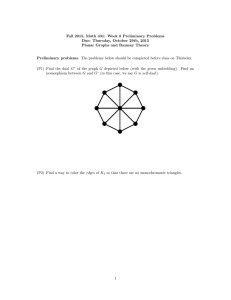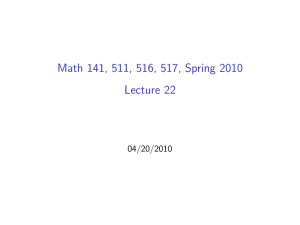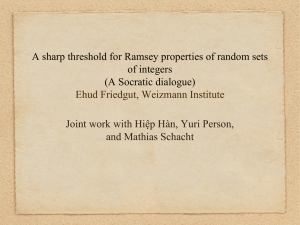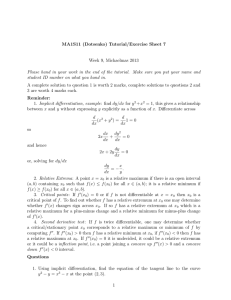An improved bound for the stepping-up lemma David Conlon Jacob Fox Benny Sudakov
advertisement
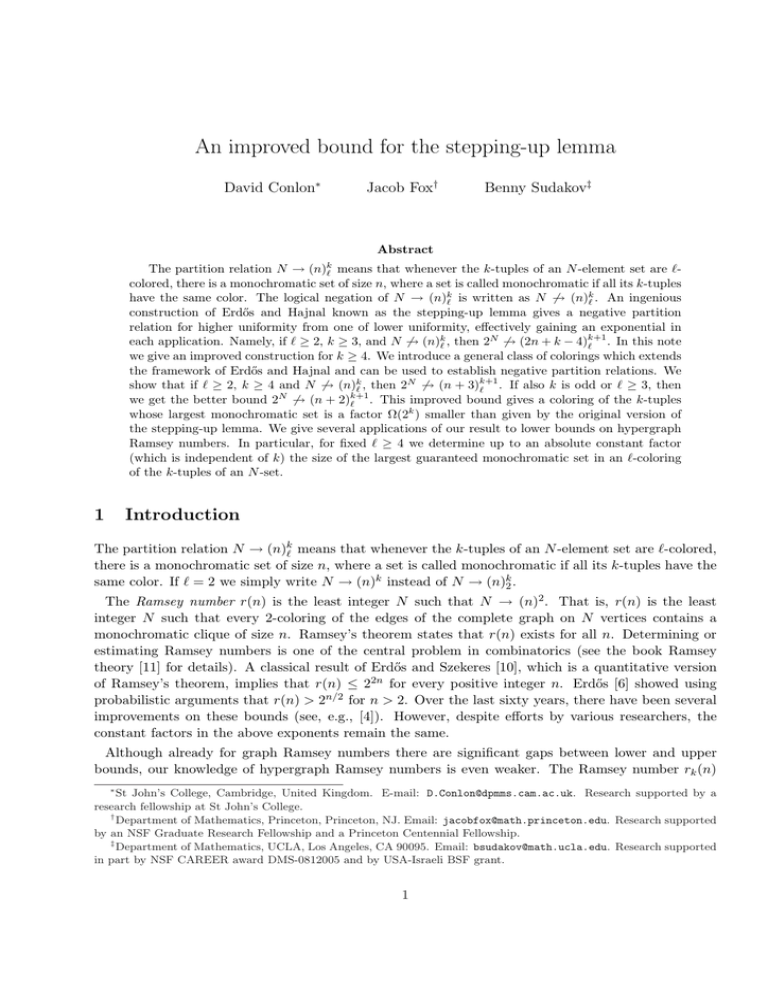
An improved bound for the stepping-up lemma
David Conlon∗
Jacob Fox†
Benny Sudakov‡
Abstract
(n)k`
The partition relation N →
means that whenever the k-tuples of an N -element set are `colored, there is a monochromatic set of size n, where a set is called monochromatic if all its k-tuples
have the same color. The logical negation of N → (n)k` is written as N 6→ (n)k` . An ingenious
construction of Erdős and Hajnal known as the stepping-up lemma gives a negative partition
relation for higher uniformity from one of lower uniformity, effectively gaining an exponential in
each application. Namely, if ` ≥ 2, k ≥ 3, and N 6→ (n)k` , then 2N 6→ (2n + k − 4)k+1
. In this note
`
we give an improved construction for k ≥ 4. We introduce a general class of colorings which extends
the framework of Erdős and Hajnal and can be used to establish negative partition relations. We
show that if ` ≥ 2, k ≥ 4 and N 6→ (n)k` , then 2N 6→ (n + 3)k+1
. If also k is odd or ` ≥ 3, then
`
we get the better bound 2N 6→ (n + 2)k+1
.
This
improved
bound
gives a coloring of the k-tuples
`
whose largest monochromatic set is a factor Ω(2k ) smaller than given by the original version of
the stepping-up lemma. We give several applications of our result to lower bounds on hypergraph
Ramsey numbers. In particular, for fixed ` ≥ 4 we determine up to an absolute constant factor
(which is independent of k) the size of the largest guaranteed monochromatic set in an `-coloring
of the k-tuples of an N -set.
1
Introduction
The partition relation N → (n)k` means that whenever the k-tuples of an N -element set are `-colored,
there is a monochromatic set of size n, where a set is called monochromatic if all its k-tuples have the
same color. If ` = 2 we simply write N → (n)k instead of N → (n)k2 .
The Ramsey number r(n) is the least integer N such that N → (n)2 . That is, r(n) is the least
integer N such that every 2-coloring of the edges of the complete graph on N vertices contains a
monochromatic clique of size n. Ramsey’s theorem states that r(n) exists for all n. Determining or
estimating Ramsey numbers is one of the central problem in combinatorics (see the book Ramsey
theory [11] for details). A classical result of Erdős and Szekeres [10], which is a quantitative version
of Ramsey’s theorem, implies that r(n) ≤ 22n for every positive integer n. Erdős [6] showed using
probabilistic arguments that r(n) > 2n/2 for n > 2. Over the last sixty years, there have been several
improvements on these bounds (see, e.g., [4]). However, despite efforts by various researchers, the
constant factors in the above exponents remain the same.
Although already for graph Ramsey numbers there are significant gaps between lower and upper
bounds, our knowledge of hypergraph Ramsey numbers is even weaker. The Ramsey number rk (n)
∗
St John’s College, Cambridge, United Kingdom. E-mail: D.Conlon@dpmms.cam.ac.uk. Research supported by a
research fellowship at St John’s College.
†
Department of Mathematics, Princeton, Princeton, NJ. Email: jacobfox@math.princeton.edu. Research supported
by an NSF Graduate Research Fellowship and a Princeton Centennial Fellowship.
‡
Department of Mathematics, UCLA, Los Angeles, CA 90095. Email: bsudakov@math.ucla.edu. Research supported
in part by NSF CAREER award DMS-0812005 and by USA-Israeli BSF grant.
1
is the minimum N such that N → (n)k . That is, rk (n) is the least N such that every 2-coloring
of the k-tuples of an N -element set contains a monochromatic set of size n, where a set is called
monochromatic if all its k-tuples have the same color. Erdős, Hajnal, and Rado [9] showed that there
are positive constants c and c0 such that
c0 n
2
2cn < r3 (n) < 22
.
cn
They also conjectured that r3 (n) > 22 for some constant c > 0 and Erdős (see, e.g. [3]) offered a
$500 reward for a proof. Similarly, for k ≥ 4, there is a difference of one exponential between known
upper and lower bounds for rk (n), i.e.,
tk−1 (c2−k n2 ) ≤ rk (n) ≤ tk (c0 n),
where the tower function tk (x) is defined by t1 (x) = x and ti+1 (x) = 2ti (x) .
The proof of the lower bound is a corollary of the following lemma of Erdős and Hajnal, known as
the stepping-up lemma (see e.g. [11]).
Theorem 1 (Stepping-up Lemma) If k ≥ 3 and N 6→ (n)k` , then 2N 6→ (2n + k − 4)k+1
.
`
2
By starting with the negative partition relation 2n /6 6→ (n)3 , which follows by considering a random 2-coloring of the triples of an N -set, after k − 3 iterations of the stepping-up lemma, we have
tk−1 (n2 /6) 6→ (2k−3 n − k + 3)k .
There is also a way to step-up from k = 2 to k = 3, but, in doing so, the number of colors jumps
from 2 to 4. However, the benefit from stepping up from k = 2 is that already for four colors we know
the correct height for the tower function. In particular, Erdős and Hajnal showed that there exist
constants c and c0 such that
cn
c0 n
22 ≤ r3 (n; 4) ≤ 22 ,
where rk (n; `) is the minimum N such that every `-coloring of the k-tuples of an N -element set contains
a monochromatic subset of size n. The relevant variant of the stepping-up lemma is as follows.
Theorem 2 (Stepping-up Lemma for k = 2) If N 6→ (n)2 , then 2N 6→ (n + 1)34 .
Using the negative partition relation 2n/2 6→ (n)2 , this gives t3 (n/2) →
6 (n + 1)34 . Through k − 3
applications of Theorem 1, we have tk (n/2) 6→ (2k−3 (n + 1) − k + 3)k4 . Thus the four-color Ramsey
number satisfies
tk (c2−k n) < rk (n; 4) < tk (c0 n),
(1)
where c and c0 are absolute constants. Satisfying as this result may be, one rather annoying aspect
remains: the exponential dependence on k of the factor of n in the lower bound. We show here that
this dependence on k can be removed. In particular, for fixed ` ≥ 4, up to an absolute constant factor,
we know the size of the largest guaranteed monochromatic set an `-coloring of the k-tuples of an N -set
must have. We accomplish this by improving the bound in the stepping-up lemma.
. If k is odd or ` ≥ 3, we have
Theorem 3 Suppose k ≥ 4 and N 6→ (n)k` . We have 2N 6→ (n + 3)k+1
`
the better bound 2N 6→ (n + 2)k+1
.
`
2
This theorem implies that for all k and n ≥ 3k the four-color Ramsey number satisfies
rk (n; 4) > tk (cn),
(2)
where c > 0 is an absolute constant. This bound improves on the lower bound in (1) and is tight
apart from the absolute constant factor c. The lower bound in (1) for k = 4 shows that N 6→ (n/3)44 ,
where N = t4 (cn) and c > 0 is an absolute constant. After k − 4 iterations of Theorem 3, we get
tk−4 (N ) 6→ (n/3 + 2(k − 4))k4 . Substituting in n ≥ 3k and N = t4 (cn), we obtain (2). The lower bound
(2) also holds for any number ` ≥ 4 of colors instead of 4 as trivially rk (n; `) ≥ rk (n; `0 ) if ` ≥ `0 , and
the upper bound in (1) holds with the same proof for any fixed number ` ≥ 4 of colors instead of 4.
Theorem 3 also allows us to improve the lower bound for two colors for n ≥ 3k to
rk (n) ≥ tk−1 (cn2 ),
where c > 0 is an absolute constant.
The off-diagonal partition relation N → (ni )ki<` means that whenever the k-tuples of an N -element
set are `-colored with colors 0, 1, . . . , ` − 1, there is a color i and a monochromatic set in color i of size
ni . The off-diagonal version of the stepping-up lemma of Erdős and Hajnal asserts that if k ≥ 3 and
N 6→ (ni )ki<` , then 2N 6→ (2ni + k − 4)k+1
i<` . Our main result is the following extension of Theorem 3.
Theorem 4 Suppose k ≥ 4 and N 6→ (ni )ki<` .
1. If ` ≥ 2, letting n0i = ni + 3 for i = 0, 1 and n0i = ni + 1 for 2 ≤ i < `, then 2N 6→ (n0i )k+1
i<` .
2. If ` ≥ 2 and k is odd, letting n0i = ni + 2 for i = 0, 1 and n0i = ni + 1 for 2 ≤ i < `, then
2N 6→ (n0i )k+1
i<` .
3. If ` ≥ 3, letting n0i = ni + 2 for i = 0, 1, 2, and n0i = ni + 1 for 3 ≤ i < `, then 2N 6→ (n0i )k+1
i<` .
Off-diagonal hypergraph Ramsey numbers have also received much interest. The Ramsey-number
rk (s, n) is the minimum N such that every red-blue coloring of the k-tuples of an N -set contains a red
s-set or a blue n-set. For k = 2, after several successive improvements, it is known (see [1], [2], [12],
[13]) that there are constants c1 , c2 such that for fixed s ≥ 3,
c1
n(s+1)/2
ns−1
≤
r
(s,
n)
≤
c
,
2
2
logt n
logs−2 n
(3)
where t = (s2 − s − 4)/(2s − 4).
Erdős and Hajnal [8] gave a simple construction showing that r3 (4, n) ≥ 2cn . They further conjectured that limn→∞ log r3n(4,n) = ∞. The authors [5] recently settled this conjecture. They also improved
on the lower and upper bounds for r3 (s, n). For s = 4, they show that there are positive constants c1
and c2 such that
2
nc1 n ≤ r3 (4, n) ≤ nc2 n .
Using the off-diagonal stepping-up lemma of Erdős and Hajnal, it follows from the above result that
for s ≥ 2k−1 − k + 3,
rk (s, n) ≥ tk−1 (c2−k n log n).
3
In the other direction, it follows from the results in [5] that rk (s, n) ≤ tk−1 (c0 ns−k+1 log n) for s ≥ k +1
and n sufficiently large. This leads to the following interesting question: what is the minimum s = s(k)
for which rk (s, n) grows at least as a tower function of height k − 1 in n? As in the cases k = 2, 3,
it is natural to conjecture that s(k) = k + 1. However, the original stepping-up lemma only gives
s(k) ≤ 2k−1 − k + 3. Our improved stepping-up lemma gives the linear upper bound s(k) ≤ d 25 ke − 3
for k ≥ 4. Indeed, starting from s(4) ≤ 7, we have s(k + 1) ≤ s(k) + 3 from the first part of Theorem
4, and we have the better bound s(k + 1) ≤ s(k) + 2 for k odd from the second part of Theorem 4.
This is a step toward the conjectured bound s(k) = k + 1.
Partition relations with infinite cardinals have an important role in modern set theory and there is
an analogous stepping-up lemma for partition relations with infinite cardinals. The still open problem
of improving the bound given by the stepping-up lemma for infinite cardinals was raised by Erdős and
Hajnal (see [7]). However, we do not investigate this problem here.
2
Step-Up Colorings
Here we construct a large family of colorings from which we derive negative partition relations in the
next section. The coloring given by Erdős and Hajnal to prove the stepping-up lemma is a particularly
simple coloring in this family.
Suppose φ : [N ]k → {0, . . . , `−1} is an `-coloring of the k-tuples of an N -set such that for 0 ≤ i ≤ `−1,
there is no monochromatic ni -set in color i. Let
T = {(γ1 , . . . , γN ) : γi = 0 or 1}.
Let P denote the family of nonempty subsets of {2, . . . , k − 1} and α a function α : P × {0, 1} →
{0, . . . , ` − 1}. The main goal of this section is to define a coloring C = Cφ,α : T → {0, . . . , ` − 1}. We
show in the next section that, for certain choices of α, if φ has no large monochromatic set, then C
also has no large monochromatic set.
0 ) and ² 6= ²0 , define
If ² = (γ1 , · · · , γN ), ²0 = (γ10 , · · · , γN
δ(², ²0 ) = max{i : γi 6= γi0 },
that is, δ(², ²0 ) is the largest coordinate at which they differ. Given this, we can define an ordering on
T , saying that
² < ²0 if γi = 0, γi0 = 1,
²0 < ² if γi = 1, γi0 = 0,
where i = δ(², ²0 ). Equivalently, associate to any ² the number b(²) =
says simply that ² < ²0 if and only if b(²) < b(²0 ).
PN
i−1 .
i=1 γi 2
The ordering then
We will further need the following two properties of the function δ which one can easily prove.
(a) If ²1 < ²2 < ²3 , then δ(²1 , ²2 ) 6= δ(²2 , ²3 ) and
(b) if ²1 < ²2 < · · · < ²p , then δ(²1 , ²p ) = max1≤i≤p−1 δ(²i , ²i+1 ).
In particular, these properties imply that there is a unique index i which achieves the maximum of
δ(²i , ²i+1 ). Indeed, suppose that there are indices i < i0 such that
` = δ(²i , ²i+1 ) = δ(²i0 , ²i0 +1 ) =
4
max δ(²j , ²j+1 ).
1≤j≤p−1
Then, by property (b) we also have that ` = δ(²i , ²i0 ) = δ(²i0 , ²i0 +1 ). This contradicts property (a)
since ²i < ²i0 < ²i0 +1 .
We are now ready to color the complete (k + 1)-uniform hypergraph on the set T . If ²1 < . . . < ²k+1 ,
for 1 ≤ i ≤ k, let δi = δ(²i , ²i+1 ). Notice that δi is different from δi+1 by property (a). If δ1 , . . . , δk
form a monotone sequence (increasing or decreasing), then let C({²1 , . . . , ²k+1 }) = φ({δ1 , . . . , δk }).
That is, we color this (k + 1)-tuple of ²’s by the color of the k-tuple of the δ’s. So suppose δ1 , . . . , δk
is not monotone.
For 2 ≤ i ≤ k − 1, we say that i is a local maximum if δi−1 < δi > δi+1 , and i is a local minimum
if δi−1 > δi < δi+1 . We say that i is a local extremum if it is a local minimum or a local maximum.
If δ1 , . . . , δk is not monotone, then, by property (a), this sequence has a local extremum. Let S =
{i1 , . . . , id }< denote the local extrema labeled in increasing order. The number ij is the location of
the jth local extremum. Note that the type of local extremum (maximum or minimum) of ij and ij+1
is different for 1 ≤ j ≤ d − 1. That is, the type of local extremum alternates. We now can define the
desired coloring:
½
α(S, 0) if i1 is a local minimum
C({²1 , . . . , ²k+1 }) =
(4)
α(S, 1) if i1 is a local maximum.
k−1
Note that the domain of α has size 2k−1 − 2, so there are `2 −2 different choices for α. That is
quite a lot of possible α to choose from! However, some choices are clearly more useful then others.
For example, they may give better negative partition relations, or may be simpler to define or analyze.
The coloring used by Erdős and Hajnal in their proof of the stepping-up lemma is given by taking α
to be the projection map onto the second coordinate. That is, they take α(S, i) = i for all S ∈ P and
i ∈ {0, 1}.
We next define two more particular functions α which we use to establish negative partition relations.
In the first coloring, the color of a (k + 1)-tuple is determined by the parity of the location and the
type of the first local extremum. Define the coloring α1 : P × {0, 1} → {0, 1, . . . , ` − 1} as follows:
α1 (S, i) = i1 + i (mod 2),
where i1 is the least element of S. Note that α1 takes only the values 0 and 1 in its image, but the
size of its range is `. If (δ1 , . . . , δk ) is not monotone, the coloring C of {²1 , . . . , ²k+1 } we get from α1
is given by
½
C({²1 , . . . , ²k+1 }) =
0
1
if i1 is even and a local min. or is odd and a local max.
if i1 is even and a local max. or is odd and a local min.
(5)
There are many more colorings similar to α1 which we can define that are useful in establishing
negative partition relations. To do so, we will consider proper colorings of a graph Gk , which we
define next. Let Gk be the graph with vertex set {2, . . . , k − 1} × {0, 1}, where (2, 0) is adjacent to
(2, 1), (j, i) is adjacent to (j + 1, i) for 2 ≤ j ≤ k − 2, (2, 0) is adjacent to (k − 1, 1), and (2, 1) is
adjacent to (k − 1, 0). Graph Gk is bipartite if and only if k is odd, and is always three-colorable. If
k is odd, the coloring χ(j, i) = j + i (mod 2) is a proper coloring, i.e., adjacent vertices get different
colors. Let χ be a proper coloring of the vertices of Gk with colors 0, 1, . . . , ` − 1. Define the coloring
αχ : P × {0, 1} → {0, 1, . . . , ` − 1} as follows:
αχ (S, i) = χ(i1 , i),
5
where i1 is the smallest element of S. Note that if k is odd, α1 is of the form αχ , with χ(j, i) = j + i
(mod 2).
In the next section, we show that coloring C with α = α1 demonstrates the first part of Theorem 4.
We then use coloring C with α of the form αχ to establish the second and third parts of Theorem 4.
3
Proof of Theorem 4
Here we prove Theorem 4. We first prove part 1 of the theorem, which states that if k ≥ 4, ` ≥ 2, and
N 6→ (ni )ki<` , letting n0i = ni + 3 for i = 0, 1 and n0i = ni + 1 for 2 ≤ i < `, then 2N 6→ (n0i )k+1
i<` . We
then prove parts 2 and 3 of Theorem 4.
Proof of Theorem 4, Part 1: Suppose φ : [N ]k → {0, . . . , ` − 1} is an `-coloring of the k-tuples of
an N -set such that for 0 ≤ i ≤ ` − 1, there is no monochromatic ni -set in color i. Let
T = {(γ1 , . . . , γN ) : γi = 0 or 1}.
We show that the coloring C : T → {0, . . . , ` − 1} defined as C = Cφ,α1 from the previous section
demonstrates the negative partition relation 2N 6→ (n0i )k+1
i<` .
We use the following simple observation several times which holds since we color each (k + 1)-tuple
of ²’s whose δ’s are monotone by the color of the k-tuple of the δ’s. If we have a monochromatic clique
with n vertices {²1 , . . . , ²n }< labeled in increasing order whose δ’s are monotone, then in coloring φ
the δ’s are the vertices of a monochromatic clique of size n − 1 in the same color.
Suppose for contradiction we have a monochromatic clique with vertices {²1 , . . . , ²n0j }< of size n0j in
color j labeled in increasing order. From the above observation, there can be no monotone consecutive
sequence of δ’s of length nj . In particular, if j > 1, since the only (k + 1)-tuples with color j are those
whose string of δ’s are monotone, there is no monochromatic clique of size nj + 1 = n0j in color j. So
we may suppose j = 0 or 1. By symmetry, we may suppose j = 0. So n00 = n0 + 3. As the sequence
δ1 , . . . , δn0 can not be monotone, there is a first local extremum e1 ≤ n0 − 1.
Case 1: The first local extremum e1 satisfies e1 > 2. Already in this case, we use the assumption
k ≥ 4. We claim that, if e1 < k, then the (k + 1)-tuples (²1 , . . . , ²k+1 ) and (²2 , . . . , ²k+2 ) have different
colors. On the other hand, if e1 ≥ k, then the (k+1)-tuples (²e1 −k+2 , . . . , ²e1 +2 ) and (²e1 −k+3 , . . . , ²e1 +3 )
have different colors. Indeed, in both cases, the first local extremum for the pair of (k + 1)-tuples are
of the same type (minimum or maximum) but their locations differ by one and hence have different
parity, which by (5) implies that these (k + 1)-tuples have different colors.
Case 2: The first local extremum is e1 = 2.
Case 2(a): 3 is a local extremum. Recall that consecutive extrema have different type and thus
types of 2 and 3 are distinct. This implies that the (k + 1)-tuples (²1 , . . . , ²k+1 ) and (²2 , . . . , ²k+2 ) have
different colors. To see this, note that for each of these (k + 1)-tuples, the first local extremum is the
second δ, but these extrema are of different type, and hence by (5) these (k + 1)-tuples have different
colors.
Case 2(b): 3 is not a local extremum. As the sequence δ2 , δ3 , . . . , δn0 +1 of length n0 cannot be
monotone, the sequence of δ’s has a second extremum e2 ≤ n0 . If e2 < k + 1, then the (k + 1)tuples (²2 , . . . , ²k+2 ) and (²3 , . . . , ²k+3 ) have different colors. If e2 ≥ k + 1, then the (k + 1)-tuples
(²e2 −k+2 , . . . , ²e2 +2 ) and (²e2 −k+3 , . . . , ²e2 +3 ) have different colors. Indeed, in either case, the first local
extremum for the pair of (k + 1)-tuples are of the same type but their locations differ by one and hence
6
have different parity, which by (5) implies that they have different colors. This completes the proof of
part 1 of the theorem.
2
The last two parts of Theorem 4 follow from the discussion at the end of the previous section together
with the following lemma. The proof is similar to the previous proof.
Lemma 1 Suppose φ : [N ]k → {0, . . . , ` − 1} is an `-coloring of the k-tuples of an N -set such that
for 0 ≤ j ≤ ` − 1, there is no monochromatic nj -set in color j. Let χ : {2, . . . , k − 1} × {0, 1} −→
{0, 1, . . . , ` − 1} be a proper coloring of the vertices of the graph Gk defined at the end of the previous
section. Then the coloring Cφ,αχ defined at the end of the previous section has no monochromatic
(nj + 2)-set in color j if j is a color used by χ, and χ has no monochromatic (nj + 1)-set in color j if
j is a color not used by χ.
Proof: For each color j not used by χ, the only (k + 1)-tuples {²1 , . . . , ²k+1 }< of color j are those
whose corresponding sequence of δ’s is monotonic. Hence, as we already explained in the proof of the
first part of Theorem 4, for each color j not used by χ, there is no monochromatic clique of size nj + 1
in color j in coloring Cφ,αχ .
So suppose for contradiction that there is a color j used by χ such that the coloring Cφ,αχ has a
monochromatic clique {²1 , . . . , ²nj +2 }< in color j. As we color the (k + 1)-tuples of ²’s whose δ’s are
monotone by the color of the k-tuples of the δ’s, there is no monotone consecutive sequence of δ’s of
length nj . As the sequence δ1 , . . . , δnj cannot be monotone, there is a first local extremum e1 ≤ nj − 1.
Case 1: The first local extremum e1 satisfies e1 > 2. If e1 < k, then the (k + 1)-tuples (²1 , . . . , ²k+1 )
and (²2 , . . . , ²k+2 ) have different colors. If e1 ≥ k, then the (k + 1)-tuples (²e1 −k+2 , . . . , ²e1 +2 ) and
(²e1 −k+3 , . . . , ²e1 +3 ) are different colors. Indeed, in either case, the first local extremum for the pair of
(k+1)-tuples are of the same type but their locations differ by one and hence, since, for all 2 ≤ j ≤ k−2
and i = 0 or 1, χ(j, i) 6= χ(j + 1, i), these (k + 1)-tuples have different colors.
Case 2: The first local extremum is e1 = 2.
Case 2(a): 3 is a local extremum. The (k + 1)-tuples (²1 , . . . , ²k+1 ) and (²2 , . . . , ²k+2 ) have different
colors. Indeed, for each of these (k + 1)-tuples, the first local extremum is the second δ, but they are
of different type, and hence, since χ(2, 0) 6= χ(2, 1), these (k + 1)-tuples have different colors.
Case 2(b): 3 is not a local extremum. As the sequence δ2 , δ3 , . . . , δnj +1 of length nj cannot be
monotone, the sequence of δ’s has a second extremum e2 ≤ nj . If e2 = nj , then the (k + 1)-tuples
(²1 , . . . , ²k+1 ) and (²nj −k+2 , . . . , ²nj +2 ) have different colors. To see this, note that their only local
extrema are the second δ and the (k − 1)th δ, respectively, and are of different type. Therefore, since
χ(2, 0) 6= χ(k − 1, 1) and χ(2, 1) 6= χ(k − 1, 0), these (k + 1)-tuples have different colors. Hence e2 < nj .
If e2 < k + 1, then the (k + 1)-tuples (²2 , . . . , ²k+2 ) and (²3 , . . . , ²k+3 ) have different colors. If
e2 ≥ k + 1, then the (k + 1)-tuples (²e2 −k+2 , . . . , ²e2 +2 ) and (²e2 −k+3 , . . . , ²e2 +3 ) are different colors.
Indeed, in either case, the first local extremum for the pair of (k + 1)-tuples are of the same type but
their locations differ by one, which, as in case 1, implies that they have different colors. This completes
the proof of the lemma.
2
References
[1] M. Ajtai, J. Komlós, and E. Szemerédi, A note on Ramsey numbers, J. Combinatorial Theory,
Ser. A 29 (1980), 354–360.
7
[2] T. Bohman and P. Keevash, in preparation.
[3] F. Chung and R.L. Graham, Erdős on Graphs. His Legacy of Unsolved Problems, A K
Peters, Ltd., Wellesley, MA, 1998.
[4] D. Conlon, A new upper bound for diagonal Ramsey numbers, Annals of Mathematics, to appear.
[5] D. Conlon, J. Fox, and B. Sudakov, Hypergraph Ramsey numbers, submitted.
[6] P. Erdős, Some remarks on the theory of graphs, Bull. Amer. Math. Soc. 53 (1947), 292–294.
[7] P. Erdős, A. Hajnal, Unsolved problems in set theory, Axiomatic Set Theory (Proc. Sympos. Pure
Math., Vol. XIII, Part I, Univ. California, Los Angeles, Calif,. 1967), pp. 17–48, Amer. Math. Soc.,
Providence, R.I., 1971.
[8] P. Erdős, A. Hajnal, On Ramsey like theorems, problems and results, Combinatorics (Proc. Conf.
Combinatorial Math., Math. Inst., Oxford, 1972) , pp. 123–140, Inst. Math. Appl., Southend-on-Sea,
1972.
[9] P. Erdős, A. Hajnal, R. Rado, Partition relations for cardinal numbers, Acta Math. Acad. Sci.
Hungar. 16 (1965), 93–196.
[10] P. Erdős and G. Szekeres, A combinatorial problem in geometry, Compositio Math. 2 (1935),
463–470.
[11] R.L. Graham, B.L. Rothschild, J.H. Spencer, Ramsey theory, 2nd edition, John Wiley & Sons
(1980).
[12] J. H. Kim, The Ramsey number R(3, t) has order of magnitude t2 / log t, Random Structures and
Algorithms 7 (1995), 173–207.
[13] J. Spencer, Asymptotic lower bounds for Ramsey functions, Discrete Math. 20 (1977/78), 69–76.
8

